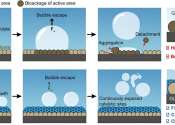Scientists create DNA hydrogel-based, solar-powered evaporation system for highly efficient seawater desalination
Minerals as well as freshwater can be obtained by desalinating seawater with solar power facilities for the sustainable development of human civilization. For instance, hydrogels have shown great power for solar-powered water ...









